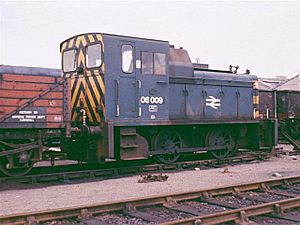British Rail Class 06 facts for kids
Quick facts for kids British Rail Class 06 |
|
 |
|
| 06009 operating as 'works pilot' at Dunfermline Townhill in July 1975 | |
| Power type | Diesel-mechanical |
|---|---|
| Builder | Andrew Barclay Sons & Co. |
| Serial number | 425–439, 452–471 |
| Build date | 1958–1960 |
| Configuration | 0-4-0 |
| UIC classification | B |
| Gauge | 4 ft 8 1⁄2 in (1,435 mm) |
| Wheel diameter | 3 ft 7 in (1.092 m) |
| Wheelbase | 7 ft 0 in (2.13 m) |
| Length | 25 ft 11 in (7.90 m) |
| Width | 8 ft 5 in (2.57 m) |
| Height | 11 ft 10+1⁄2 in (3.62 m) |
| Locomotive weight | 37.30 long tons (37.9 t) |
| Fuel capacity | 325 imp gal (1,480 L; 390 US gal) |
| Prime mover | Gardner 8L3 |
| Transmission | Wilson-Drewry CA5 5-speed epicyclic gearbox, Vulcan-Sinclair type 23 fluid coupling, Wiseman type 15 RLGB reversing gearbox and final drive |
| Top speed | 22.8 mph (36.7 km/h) |
| Power output | Engine: 204 hp (152 kW) |
| Tractive effort | Maximum: 19,800 lbf (88.1 kN) |
| Locomotive brakeforce | 15 long tons-force (149 kN) |
| Train brakes | Vacuum |
| Career | British Railways |
| Number in class | 35 |
| Number | D2410–D2444, later 06001–06010 |
| Axle load class | RA 6 (RA 5 from 1969) |
| Retired | 1967–1981 |
The British Rail Class 06 was a type of small diesel engine. These engines were built to move railway cars around in busy areas. They are known as "shunters" or "switchers."
These locomotives were built by a company called Andrew Barclay between 1958 and 1960. They were mainly used in the Scottish part of the British Railways network.
Contents
What is a Shunter?
A shunter is like a small, strong tractor for trains. Its main job is to move railway wagons and coaches around. They work in places like train yards or industrial areas. Shunters help put trains together or take them apart. They also move cars to different tracks for loading or unloading.
These locomotives are not built for high speeds. Instead, they are designed for pulling heavy loads slowly. This makes them perfect for their important work in busy rail yards.
Design and Power
The Class 06 locomotives were "diesel-mechanical." This means they used a diesel engine to create power. This power was then sent to the wheels using a special gearbox, much like a car.
- They had a Gardner 8L3 engine. This engine gave them about 204 horsepower.
- Their top speed was around 22.8 miles per hour (36.7 km/h). This speed was good enough for shunting duties.
- The locomotives weighed about 37.30 long tons (37.90 tonnes). This weight helped them grip the tracks and pull heavy loads.
How Many Were Built?
A total of 35 Class 06 locomotives were built. They were first given numbers like D2410 to D2444. Later, some of them received new numbers, from 06001 to 06010. This change happened when British Railways updated its numbering system.
Where They Worked
These locomotives were mostly used in Scotland. They helped keep the Scottish railway network running smoothly. They moved goods wagons and passenger coaches where they needed to be.
Retirement
The Class 06 locomotives served British Railways for many years. They started to be taken out of service in 1967. The last ones were retired in 1981. After their hard work, they were replaced by newer, more modern shunting engines.
Images for kids


